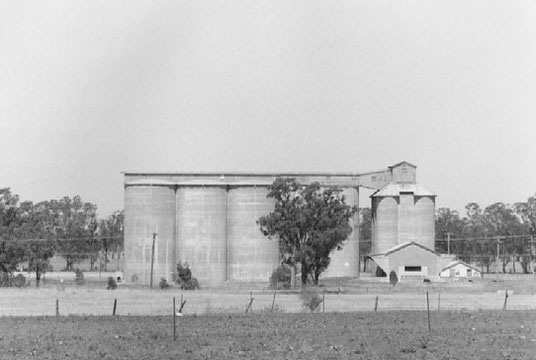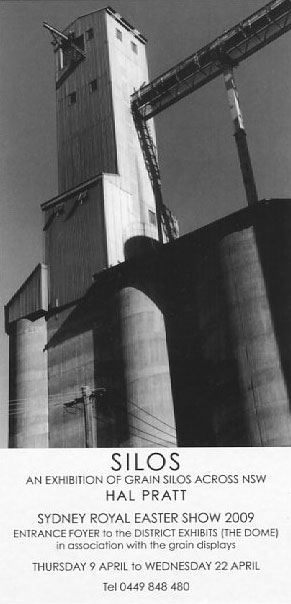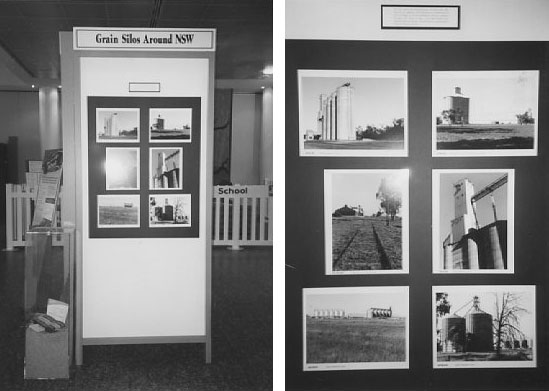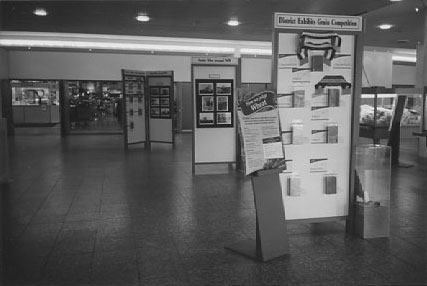NSW Silos Photographs
History
If you have a story to add to this page then please >>> click here to contact us by email.
First Silo at Peak Hill
Peak Hill ,half-way between Parkes and Narromine is the site of the first country silo built in NSW. Other silos were under construction at the same time however Peak Hill was the first to begin operating in 1918. The first two years saw little wheat delivered to the new silo as 1918 & 1919 were very dry years,with only 14 & 12 inches of rain respectively. A bumper crop in 1920 saw the silo filled for the first time.

Extract from The Sydney Mail, 14 th August 1918 :
‘A satisfactory trial was recently made at Peak Hill [writes our correspondent] of the first of the completed silos for the bulk handling of wheat. Many farmers were present from the neighbouring districts, as well as from distant parts of the state and from Victoria, to witness the demonstration. Two truck loads of wheat were brought for the test, and about a dozen wheat lumpers were instructed to take bags from the trucks, cut them open, and empty the contents into what is called the receiving grating of the elevator leg. The machinery was driven by a Ronaldson oil engine. It soon became apparent that although the men were going as fast as they could possibly go,the receiving grating was eating up the wheat faster than they could put it in, notwithstanding that the engine was only going at a medium rate of speed. A number of farmers then took a hand at opening the bags with pocket-knives. The truck of 200 bags was put through in 18 minutes at a rate of about 2000 bushels an hour. It is estimated with a greater engine speed 2300 bushels per hour could be handled. The elevator leg mentioned is part of the machinery to be installed in the future when grain will be received in bulk and emptied direct into the leg grating. It will be necessary one day to load grain in bulk from the silo to the trucks and with a leg of this capacity 4 trucks per hour will be easily loaded.”
Hal Pratt’s Story…
In 2003 Hal Pratt was contracted by the State Library of NSW to photograph every “public” silo across the state for inclusion in the Library’s archives.
Hal Pratt grew up in Parkes when it was the centre of the wheat belt. The local silos were close by and visible from the front veranda. Trucks would queue for days in his street waiting to offload bagged wheat at the rail terminal. Undoing each bag was a very slow process compared with the bulk handling today.
Later as a practicing architect Hal maintained an interest in silo buildings. A career change to photography presented an opportunity to cover both interests by recording these landmark structures.
There are roughly 350 silo locations in the grain belt between the Queensland and Victorian borders. The growing area roughly straddles the 500mm [20 inch] per annum rainfall contour. The silos are located on the original rail network although sadly today many of the lines have been abandoned.
After six years of travelling many thousands of kilometres across NSW the photographic side of this project is almost complete. Each trip from Hal’s home in Wollongong is carefully planned and recorded. A report from the State Library’s archives lists each location and its rail link. With this report and detailed maps Hal follows the rail lines making sure that there is a manageable number of silos to photograph in any one day and that none are missed. Up to 15 silos are photographed in a day.
The photographs exhibited here highlight a diversity of structure and location. The original concrete silos stand out as significant landmarks. The more recent steel bulkheads are less permanent but have a much greater capacity than the original cylindrical bins. The most recent form of storage, the” bunker”,is cheap and expedient but has no architectural merit.Grain is simply dumped on graded ground and covered with a tarpaulin which is fixed to a low perimeter wall.
ABC Radio 18 Sep 2009 ‘Country Hour”
Junee Licorice and Chocolate have bought [ for $1] the Cowora flour mill from the local council. The buildings constructed in the 1920s will be converted to house a distillery for making organic whisky.The whisky will be made with Riverina barley—“the best in the world for making whisky’. [see photograph under category “C’]
ABC Radio 21 Sep 2009 ‘Country Hour”
Western Cereal Industries is to close Gulgong flour mill [“too small’].Will not adversely affect local supply of grain as most of the wheat and other grains comes from South Australia. The company is also reviewing the viability of the Tamworth feed mill.
Exhibition RES 2009
The NSW Silos photographs were displayed at the last Royal Easter Show in Sydney at The Districts Exhibits in The Dome.


